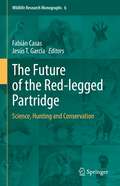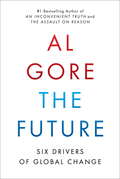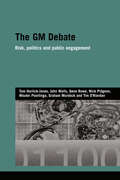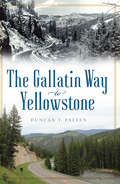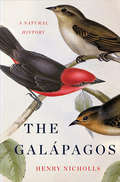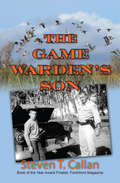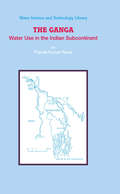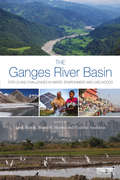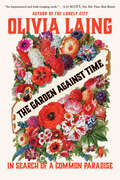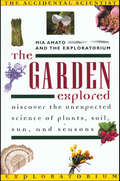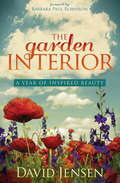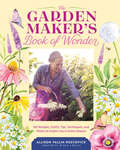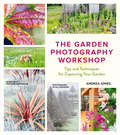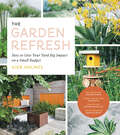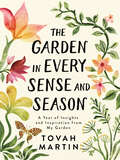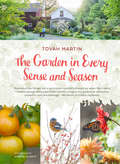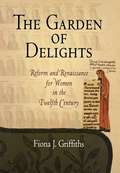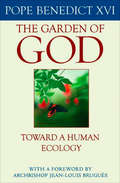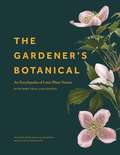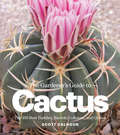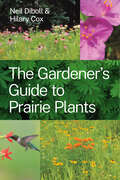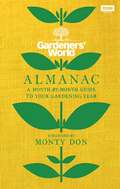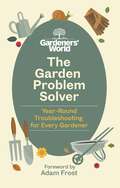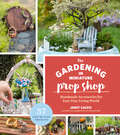- Table View
- List View
The Future of the Red-legged Partridge: Science, Hunting and Conservation (Wildlife Research Monographs #6)
by Fabián Casas Jesús T. GarcíaThere has been a recent upsurge of red-legged partridge research in most countries where the species is distributed, but no comprehensive review of that fresh and relevant multidisciplinary and international knowledge is available. In fact, this is probably the first scientific book on this important species, apart from Dick Potts’ excellent works on British-introduced population, or ONCFS’s (Office Nationale de la Chasse et le Faune Sauvage, France) older technical reports. This is in strong contrast with a plethora of literature in hunting magazines or non-academic books, not often precise, realistic, or well informed. Thus, the book fills a great bibliography gap that could have important social impact. The common thread of the book is the prominent role a species like this may play for research, from basic physiological or ecological knowledge to socio-economics of hunting and the rural world. The general framework of the book [I1] is the important role that hunting and game management may play in both rural economies and biodiversity conservation, with the partridge as flag species, and also in identifying the “dark drift” that industrial, incorrectly deployed management, or hunting vision may have on both sustainability of resources and nature conservation at large. The final aim of the book is identifying the best future scenario, both for partridge hunters and managers as well as the general public.
The Future: Six Drivers of Global Change
by Al GoreFrom the former vice president and #1 New York Times bestselling author comes An Inconvenient Truth for everything--a frank and clear-eyed assessment of six critical drivers of global change in the decades to come. Ours is a time of revolutionary change that has no precedent in history. With the same passion he brought to the challenge of climate change, and with his decades of experience on the front lines of global policy, Al Gore surveys our planet's beclouded horizon and offers a sober, learned, and ultimately hopeful forecast in the visionary tradition of Alvin Toffler's Future Shock and John Naisbitt's Megatrends. In The Future, Gore identifies the emerging forces that are reshaping our world: * Ever-increasing economic globalization has led to the emergence of what he labels "Earth Inc."--an integrated holistic entity with a new and different relationship to capital, labor, consumer markets, and national governments than in the past. * The worldwide digital communications, Internet, and computer revolutions have led to the emergence of "the Global Mind," which links the thoughts and feelings of billions of people and connects intelligent machines, robots, ubiquitous sensors, and databases. * The balance of global political, economic, and military power is shifting more profoundly than at any time in the last five hundred years--from a U.S.-centered system to one with multiple emerging centers of power, from nation-states to private actors, and from political systems to markets. * A deeply flawed economic compass is leading us to unsustainable growth in consumption, pollution flows, and depletion of the planet's strategic resources of topsoil, freshwater, and living species. * Genomic, biotechnology, neuroscience, and life sciences revolutions are radically transforming the fields of medicine, agriculture, and molecular science--and are putting control of evolution in human hands. * There has been a radical disruption of the relationship between human beings and the earth's ecosystems, along with the beginning of a revolutionary transformation of energy systems, agriculture, transportation, and construction worldwide. From his earliest days in public life, Al Gore has been warning us of the promise and peril of emergent truths--no matter how "inconvenient" they may seem to be. As absorbing as it is visionary, The Future is a map of the world to come, from a man who has looked ahead before and been proven all too right.
The GM Debate: Risk, Politics and Public Engagement (Genetics and Society)
by Graham Murdock Tim O'Riordan Tom Horlick-Jones John Walls Gene Rowe Nick Pidgeon Wouter PoortingaThis book tells the story of an unprecedented experiment in public participation: the government-sponsored debate on the possible commercialization of ‘GM’ crops in the UK. Giving a unique and systematic account of the debate process, this revealing volume sets it within its political and intellectual contexts, and examines the practical implications for future public engagement initiatives. The authors, an experienced team of researchers, produce a conceptually-informed and empirically-based evaluation of the debate, drawing upon detailed observation of both public and behind-the-scenes aspects of the process, the views of participants in debate events, a major MORI-administered survey of public views, and details of media coverage. With innovative methodological work on the evaluation of public engagement and deliberative processes, the authors analyze the design, implementation and effectiveness of the debate process, and provide a critique of its official findings. The book will undoubtedly be of interest to a wide readership, and will be an invaluable resource for researchers, policy-makers and students concerned with cross-disciplinary aspects of risk, decision-making, public engagement, and governance of technology.
The Gallatin Way to Yellowstone (Transportation)
by Duncan T. PattenThe Gallatin Way, a picturesque route heading south through the canyon to the west gate of Yellowstone, boasts a history covering more than a century of exploration, homesteading and development. Early pioneers and adventurers endured a rugged and unforgiving terrain where today's travelers speed along a modern highway. One might expect to see dramatic shifts, yet little change is evident in some areas, while others teem with contemporary luxuries. Pairing historic and modern photography of the same locations, Duncan T. Patten retraces the marvel of this iconic thoroughfare.
The Galápagos: A Natural History
by Henry NichollsThe natural and human history of the Galapagos Islands--beloved vacation spot, fiery volcanic chain, and one of the critical sites in the history of science The Galapagos were once known to the sailors and pirates who encountered them as Las Encantadas: the enchanted islands, home to exotic creatures and dramatic volcanic scenery. In The Galapagos, science writer Henry Nicholls offers a lively natural and human history of the archipelago, charting its evolution from deserted wilderness to scientific resource (made famous by Charles Darwin) and global ecotourism hot spot. He describes the island chain’s fiery geological origins as well as the long history of human interaction with it, and draws vivid portraits of the Galapagos’ diverse life forms, capturing its awe-inspiring landscapes, its understated flora, its stunning wildlife and, crucially, the origin of new species. Finally, he considers the immense challenges facing the islands and what lies ahead. Nicholls shows that what happens in the Galapagos is not merely an isolated concern, but reflects the future of our species’ relationship with nature--and the fate of our planet.
The Game Warden's Son
by Steven T. CallanA game warden’s “dynamic and authoritative” memoir of protecting the wild, named Best Outdoor Book of 2016 by the Outdoor Writers Association of California (New York Daily News). Retired game warden Steven T. Callan’s love of nature and passion for protecting wildlife took root long before the adventures he describes in his acclaimed memoir, Badges, Bears, and Eagles. In this follow up, he intertwines more than a half-century of adventures and investigations with stories of his relationship with his father. After an idyllic boyhood spent riding on patrol with his father in the canyons and beaches of California, Steven himself became a game warden in the early 1970s, joining the “desert rats” who patrolled the counties along the Colorado River. With wry humor, Callan tells how he and fellow officers outwitted perpetrators—most of them crafty, some of them hilariously foolish—who poached deer, lobsters, and abalone, baited bears, shot wild ducks to supply restaurants, and killed songbirds for epicurean dinner tables. Their cases took them across the Channel Islands, through the back alleys of San Francisco, into the Sierras, and along California’s pristine North Coast—all to protect California’s natural resources for future generations. “Callan’s writing is dynamic and authoritative, with an episodic structure that will keep experts and novice readers turning the pages” (New York Daily News).
The Ganga
by Pranab Kumar ParuaThe geo-hydro-morphometry of the river Ganges has a history of long and wide variations as the river is continuously fed by the high Himalayas hill ranges, the highest in the world. The river is categorized as an international one, passing through several independent countries. The major flow of the river used to flow through the branch river, Bhagirathi-Hooghly on the banks of which both city and port of Calcutta (now renamed Kolkata) are situated. However, due to massive tectonic and morphological changes, the flow through the branch river has gradually decreased resulting in enormous damages to the port and the city. After more than a century of investigations on the probable causes of deterioration and its remedies, a barrage across the river had been constructed near a place called Farakka in the Murshidabad district of West Bengal, India for diversion of a part of lean season flow (40,000 cu secs) from the parent river to the branch river for the resuscitation of the branch river and revitalization of the port of Calcutta. The turmoil started since the construction of barrage between 1965-1975 and the major neighbouring countries, India and Bangladesh, were locked in the dispute over sharing the water of the parent river. After several rounds of discussions at different levels between the two countries, short-term agreements were signed two times, one in 1977 and the other in 1985, and finally one long term Treaty was signed in 1996 between the two countries in an atmosphere of peaceful co-existence. Audience: The book will be of interest to researchers and scientists, professionals and policymakers in water resources management and environmental science, conservation policy and development research.
The Ganges River Basin: Status and Challenges in Water, Environment and Livelihoods (Earthscan Series on Major River Basins of the World)
by Vladimir Smakhtin Luna Bharati Bharat R. SharmaThe Ganges is one of the most complex yet fascinating river systems in the world. The basin is characterized by a high degree of heterogeneity from climatic, hydrological, geomorphological, cultural, environmental and socio-economic perspectives. More than 500 million people are directly or indirectly dependent upon the Ganges River Basin, which spans China, Nepal, India and Bangladesh. While there are many books covering one aspect of the Ganges, ranging from hydrology to cultural significance, this book is unique in presenting a comprehensive inter-disciplinary overview of the key issues and challenges facing the region. Contributors from the three main riparian nations assess the status and trends of water resources, including the Himalayas, groundwater, pollution, floods, drought and climate change. They describe livelihood systems in the basin, and the social, economic, geopolitical and institutional constraints, including transboundary disputes, to achieving productive, sustainable and equitable water access. Management of the main water-use sectors and their inter-linkages are reviewed, as well as the sustainability and trade-offs in conservation of natural systems and resource development such as for hydropower or agriculture.
The Garden (Early Reader Non Fiction)
by Louisa LeamanEarly Readers are stepping stones from picture books to reading books. A green Early Reader is a first factbook.It's never too early to find out about... The Garden.Bugs and beetles, birds and plants, there's a world to be discovered and it's right on your doorstep. Beautifully illustrated in full colour on every page, this new Early Reader will show you the amazing possibilities of the great outdoors!
The Garden Against Time: In Search of a Common Paradise
by Olivia LaingFinalist for the 2024 Kirkus Prize for Nonfiction Finalist for the 2024 Wainwright Prize for Nature Writing A #1 Sunday Times (UK) Bestseller • A New York Times Book Review Editors' Choice • A Kirkus Reviews "Best Book of the 21st Century (So Far)" • A New Yorker Best Book of 2024 • A Chicago Public Library Must-Read Book of 2024 • An Oprah Daily "Most Thought-Provoking Book" of 2024 "An impassioned and wide-ranging work." —A.O. Scott, New York Times Book Review Inspired by the restoration of her own garden, "imaginative and empathetic critic" (NPR) Olivia Laing embarks on an exhilarating investigation of paradise. In 2020, Olivia Laing began to restore an eighteenth-century walled garden in Suffolk, an overgrown Eden of unusual plants. The work brought to light a crucial question for our age: Who gets to live in paradise, and how can we share it while there’s still time? Moving between real and imagined gardens, from Milton’s Paradise Lost to John Clare’s enclosure elegies, from a wartime sanctuary in Italy to a grotesque aristocratic pleasure ground funded by slavery, Laing interrogates the sometimes shocking cost of making paradise on earth. But the story of the garden doesn’t always enact larger patterns of privilege and exclusion. It’s also a place of rebel outposts and communal dreams. From the improbable queer utopia conjured by Derek Jarman on the beach at Dungeness to the fertile vision of a common Eden propagated by William Morris, new modes of living can and have been attempted amidst the flower beds, experiments that could prove vital in the coming era of climate change. The result is a humming, glowing tapestry, a beautiful and exacting account of the abundant pleasures and possibilities of gardens: not as a place to hide from the world but as a site of encounter and discovery, bee-loud and pollen-laden.
The Garden Explored: Discover the Unexpected Science of Plants, Soil, Sun, and Seasons
by Mia Amato The ExploratoriumWhat makes your garden grow? Find out with author Mia Amato's The Garden Explored. This bookoffers a basketful of tips on understanding everything from basic soil chemistry to the inner life of plants. With Mia Amato as your guide, discover the unexpected science of plants, soil, sun and seasons.
The Garden Interior: A Year of Inspired Beauty
by David JensenA memoir &“brimming with expertise and commentary and leavened with quirky humor, endearing humility, and a sense of wonder&” (Philadelphia Inquirer). The Garden Interior is the story of how one great garden raised a family—and of what goes on inside the heart and mind of a gardener. Against the backdrop of one modern-day family growing up in a rambling old arts and crafts house with a gorgeous acre of lush, mature gardens, this loving memoir is filled with gardening wisdom, humor, and nostalgia for the 1960s and &’70s. It is also loaded with distinctive foodie tips and recipes that will inspire you, whether you are a gardener or not. You&’ll experience a garden in each month of the calendar and encounter a lively and readable guide to being a better and more engaged gardener by understanding the rich interior life of this beautiful discipline and craft. The Garden Interior is more than the story of a family and gardening, though. It is about persistence, hope, letting go, and saying goodbye to our gardens, to our homes, and to our children. It is about letting the things and people we love fulfill their own destinies and be what they must be. It is about navigating love and loss and change by surrendering the self and practicing humble acceptance. The Garden Interior is a powerful read for anyone who has had these life experiences, in seasons of both sadness and joy.
The Garden Maker's Book of Wonder: 162 Recipes, Crafts, Tips, Techniques, and Plants to Inspire You in Every Season
by Allison Vallin KostovickThe joy and wonder of a garden-inspired lifestyle is captured in this colorfully photographed, through-the-seasons sourcebook filled with recipes, gardening wisdom, craft and wellness projects, and nature-based activities. Each season in the garden brings new joy and fresh inspiration for connecting with the wonders of the natural world. In The Garden Maker's Book of Wonder, popular gardening lifestyle influencer Allison Vallin Kostovick (Finch + Folly) invites fans of cottagecore, gardening, and nature-based living to share her journey as she crafts, cooks, dreams, and creates. Drawing on decades of gardening experience, and illustrated with vibrant photography from her own home and garden, The Garden Maker's Book of Wonder offers sage advice on growing bountiful harvests of favorite vegetables, herbs, and flowers. All levels of gardeners, from dreamers to the experienced, will delight in the variety and creativity of Kostovick's projects, activities, and recipes for enjoying the magic and whimsy of the natural world—no matter what season. From planting a pollinator playground to building a rustic trellis from tree branches, cooking with freshly picked peas and mint to making a sweet viola tub soak, and growing a bird seed mix to crafting one-of-a-kind jewelry beads from the husks of the Job's Tears plant, the inventive ideas in this rich treasury are sure to make it a favorite to keep and to give to anyone who aspires to a more nature-connected lifestyle. This publication conforms to the EPUB Accessibility specification at WCAG 2.0 Level AA.
The Garden Photography Workshop: Expert Tips and Techniques for Capturing the Essence of Your Garden
by Andrea JonesLearn to take better garden photos! One of the most rewarding aspects of gardening is sharing its beauty, both physically with those who visit and virtually with those who only see it on a screen. But capturing a garden’s true essence is difficult, and often the moments worth sharing are ephemeral. In The Garden Photography Workshop, internationally known garden photographer Andrea Jones shares the trade secrets that make her photos sing. You’ll learn the basic photography skills and tips on using a range of camera equipment. Profiles of real gardens from around the world exemplify the most common problems a photographer can face, like harsh light, wet weather, and cramped spaces, along with advice and techniques for addressing specific concerns. We live in a photo-driven world, and this helpful guide is a complete tutorial for anyone who wants that world to be filled with beautiful images of gardens and plants.
The Garden Refresh: How to Give Your Yard Big Impact on a Small Budget
by Kier HolmesGrow more, spend less So you want a stylish, healthy, and productive garden that is budget and Earth-friendly? Of course you do. Garden designer Kier Holmes shows you how, in this accessible and spunky guide. She shares everything you need to create a productive and lush garden that can truly be used and enjoyed. Packed with hundreds of tips on design, plant selection, and how to address problematic situations, it also has information on which hardscape elements are worth the splurge, how to decide where to start, and how to reduce maintenance through design. Inspirational, practical, and endlessly creative, The Garden Refresh is destined to become the book you turn to again and again for the best insider ideas.
The Garden in Every Sense and Season: A Year of Insights and Inspiration from My Garden
by Tovah Martin&“Reminds us that the best way to get to know a garden is through our senses. Don't expect to make it through many pages before you feel an urge to run outdoors to reintroduce yourself to your own landscape.&” —Michelle Slatalla, Gardenista So much of gardening is focused on seasonal to-do lists and daily upkeep. But what about taking time to just enjoy the garden? The Garden in Every Sense and Season urges you to revel in what you&’ve created. From the heady fragrance of spring lilacs to the delicious silence of a winter snowfall, writer and lifelong gardener Tovah Martin explores the glories of her garden using the five senses. Her sage advice and gratifying reflections on the rewards of a more mindful way of gardening will inspire you to look closer, breathe deeper, listen harder, and truly savor the gifts of your garden.
The Garden in Every Sense and Season: Gardening to Awaken Your Five Senses
by Tovah Martin Kindra Clineff“Reminds us that the best way to get to know a garden is through our senses.” —Gardenista So much of gardening is focused on the long list of chores—the weeding, planting, and pruning. But what about the joy a garden can provide? In The Garden in Every Sense and Season, Tovah Martin explores the sensory delights in her own garden in 100 evocative essays. Martin shares sage garden advice, offers intimate reflections on her own garden, and urges us to inhale, savor, and become more attuned to our gardens. Packed with lush color photographs, The Garden in Every Sense and Season will help you grow a bounty of gratitude in your own home garden.
The Garden of Delights
by Fiona J. GriffithsIn The Garden of Delights, Fiona J. Griffiths offers the first major study of the Hortus deliciarum, a magnificently illuminated manuscript of theology, biblical history, and canon law written both by and explicitly for women at the end of the twelfth century. In so doing she provides a brilliantly persuasive new reading of female monastic culture. Through careful analysis of the contents, structure, and organization of the Hortus, Griffiths argues for women's profound engagement with the spiritual and intellectual vitality of the period on a level previously thought unimaginable, overturning the assumption that women were largely excluded from the "renaissance" and "reform" of this period. As a work of scholarship that drew from a wide range of sources, both monastic and scholastic, the Hortus provides a witness to the richness of women's reading practices within the cloister, demonstrating that it was possible, even late into the twelfth century, for communities of religious women to pursue an educational program that rivaled that available to men. At the same time, the manuscript's reformist agenda reveals how women engaged the pressing spiritual questions of the day, even going so far as to criticize priests and other churchmen who fell short of their reformist ideals.Through her wide-ranging examination of the texts and images of the Hortus, their sources, composition, and function, Griffiths offers an integrated understanding of the whole manuscript, one which highlights women's Latin learning and orthodox spirituality. The Garden of Delights contributes to some of the most urgent questions concerning medieval religious women, the interplay of gender, spirituality, and intellectual engagement, to discussions concerning women scribes and writers, women readers, female authorship and authority, and the visual culture of female communities. It will be of interest to art historians, scholars of women's and gender studies, historians of medieval religion, education, and theology, and literary scholars studying questions of female authorship and models of women's reading.
The Garden of God: Toward a Human Ecology
by Pope Benedict XVIIn this collection of his writings, Pope Benedict XVI speak to the important relationships between the environment, Catholic social teaching, and theology. During his papacy, Pope Benedict XVI repeatedly drew attention to the environment. He spoke of preserving it, such as his address concerning the Amazon rainforest and his letter regarding the Arctic, and of distributing its vital resources—such as water—more equitably. Benedict led by example when the Vatican became the first carbon-neutral country in the world. This book collects Benedict&’s many audiences, addresses, letters, and homilies on a wide range of topics dealing with the world about us. The major themes and connections he explores include creation and the natural world; the environment, science, and technology; and hunger, poverty, and the earth&’s resources. In these pages, Benedict insists that if we truly desire peace, we must consciously nurture all of creation. He speaks in favor of alternative energy while speaking out against the spread of nuclear weapons and threats to biodiversity. He urges sustainable development, equitable distribution of food and water, and an end to hunger. In summation, Benedict argues that our love of God should cause us to protect the environment, and that in turn, our heightened appreciation of the natural world will draw us closer to God.
The Gardener's Botanical: An Encyclopedia of Latin Plant Names - with More than 5,000 Entries
by The Gardener's B Ross BaytonThe definitive guide to botanical Latin. Unlock the secrets of botanical Latin with this beautifully illustrated encyclopedia. The Gardener's Botanical contains definitions of more than 5,000 plant names—from abbreviatus ("shortened") to zonatus ("with bands")—along with more than 350 color illustrations. Scientific plant names are an invaluable tool for those who understand them. Formed from Greek and, more commonly, from Latin root words, not only do they make it possible for gardeners and botanists to communicate, they also contain a wealth of hidden information. The Gardener's Botanical is the key to unlocking these secrets. This guide contains a breathtaking array of botanical names in alphabetical order. Each word is listed with a pronunciation guide, definition, example plant, and, where appropriate, etymology. Also included in this illuminating guide are special features on important plant genera, fact boxes, essays focusing on the history and importance of Latin names and botanical illustrations, and an index of common names with more than 2,000 popular plants, cross-referenced with their binomial name in Latin.
The Gardener's Guide to Cactus: The 100 Best Paddles, Barrels, Columns, and Globes
by Scott CalhounWhen it comes to garden plants, cacti are anything but standard issue. The bulk of home gardens contain exactly zero species of cactus, and the thought of growing them makes gardeners think, “Ouch!” In The Gardener’s Guide to Cactus: The 100 Best Paddles, Barrels, Columns, and Globes, Scott Calhoun is out to change that perception, and bring the beauty and ease of cactus home. It’s high time that cacti took their place alongside the trendy succulent.
The Gardener's Guide to Prairie Plants (Emersion: Emergent Village Resources For Communities Of Faith Ser.)
by Neil Diboll Hilary CoxA comprehensive and beautifully illustrated reference for all gardeners passionate about native plants and prairie restoration. The Gardener’s Guide to Prairie Plants is the one-stop compendium for all gardeners aspiring to use native prairie plants in their gardens. Neil Diboll and Hilary Cox—two renowned prairie gardeners—compile more than four decades’ worth of research to offer a wide-ranging and definitive reference for starting and maintaining prairie and meadow gardens and restorations. Alongside detailed synopses of plant life cycles, meticulous range maps, and sweeping overviews of natural history, Diboll and Cox also include photographs of 148 prairie plants in every stage of development, from seedling to seedhead. North America’s grasslands once stretched from the Blue Ridge to the Rocky Mountains, and from Texas to Manitoba, blanketing the mid-continent with ecologically important, garden-worthy, native species. This book provides all the inspiration and information necessary for eager native planters from across the country to welcome these plants back to their landscapes. The Gardener’s Guide to Prairie Plants is a must-have reference for gardeners, restorationists, and every flora fan with a passion for native plants, prairies and meadows.
The Gardeners’ World Almanac: A month-by-month guide to your gardening year
by Gardeners' World MagazineThe team at Gardeners' World bring you the ultimate guide to your gardening year, from planning and planting to troubleshooting tips and gardening discovery. Organised by month, this book includes lists, timetables, step-by-step guidance and expert advice for year-round gardening, as well as an informative guide on what to plant when and projects for every season. Complemented by beautiful hand-drawn illustrations and tips from your favourite gardening personalities, The Gardeners' World Almanac will help you make your garden look its very best throughout the year.
The Gardeners’ World Problem Solver: Year-Round Troubleshooting for Every Gardener
by Adam Frost BBC Gardeners’ World MagazineEven with the best planning and care, every garden can run into a problem or two. Whether you are beset with beetles or blighted by blackspot, The Garden Problem Solver has the solution.Guided by the team of experts at Gardeners' World - including advice from Monty Don, Alan Titchmarsh, Carol Klein, Arit Anderson, Adam Frost and more - The Garden Problem Solver contains the practical tips, tricks and techniques to deal with the obstacles that every home gardener has to face.Broken down into easy-to-follow steps, this handy guide will help you anticipate, avoid and troubleshoot the most common garden problems which crop up when growing your favourite fruit, veg, flowers and more.With a foreword by Adam Frost and complemented with hand-drawn illustrations, The Garden Problem Solver holds the secrets to making your garden look its very best.
The Gardening in Miniature Prop Shop: Handmade Accessories for Your Tiny Living World
by Janit CalvoA not-so-mini trend The Gardening in Miniature Prop Shop is the next big thing for the crafters and gardeners already captivated by gardening small. Organized by playful themes—including gardens around the world, holidays, and fantasy gardens—it’s a fun-filled guide to creating one-of-a-kind gardens and the accessories that make them shine. Thirty-seven projects are included with fully illustrated, step-by-step instructions. For a Japanese garden, you will learn how to create a miniature sand garden. For a Halloween garden, you'll learn how to make a flying ghost and zombie. And for a space garden, you'll learn how to make a tiny space ship and alien. The Gardening in Miniature Prop Shop is for anyone enchanted by the whimsy of creating a tiny world.
